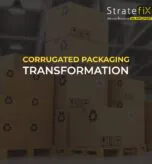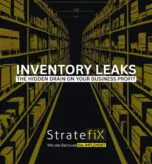Established in 2010, this Daman-based leader in corrugated packaging solutions has built a reputation for innovation, sustainability, and customer-centric service. Producing over 60,000 boxes, tubes, and cores daily from 100% recycled craft paper and water-based inks, the company has become a preferred partner for leading FMCG, e-commerce, and industrial brands. Its relentless focus on eco-friendly processes, design excellence, and on-time delivery fueled rapid market expansion. As order volumes surged and product lines diversified, operational challenges emerged fragmented workflows, untracked downtime, inconsistent reporting, and siloed data. These issues threatened throughput reliability, cost control, and agility necessary to maintain competitive advantage in the evolving green packaging landscape. Growing demand underscored the need for systemic improvements to protect quality, enhance efficiency, and support future innovation.
Key Operational Challenges
Despite strong foundations, the corrugated packaging manufacturer’s growth brought several critical operational hurdles:
- Inconsistent Processes
Lack of standardized workflows across production stages caused bottlenecks and variable cycle times. Informal operator practices led to inconsistent quality and disrupted delivery schedules. - Quality Reporting Gaps
Fragmented defect tracking prevented effective root-cause analysis. Recurring issues like liner wastage and reel joint failures persisted due to inconsistent quality monitoring. - Rising Wastage & Downtime
Untracked machine stoppages and maintenance delays increased scrap and idle time. Critical equipment issues were handled reactively without systematic downtime data. - ERP Underutilization
Disconnected systems limited real-time visibility into orders, inventory, and production. This hindered efficient resource planning and performance monitoring. - Human Resource Gaps
Undefined roles, unstructured hiring, and lack of training impeded skill development and ownership of quality objectives. - Communication Barriers
Poor cross-departmental communication delayed issue resolution and feedback, limiting continuous improvement efforts.
These challenges manifested in production delays, unpredictable output, escalating costs, and reduced customer satisfaction, ultimately stifling agility and eroding profitability in a competitive market.
Stratefix’s Comprehensive Solution
- ERP Integration & Shop-Floor Visibility
Stratefix unified fragmented systems into a single ERP platform, providing real-time dashboards that track cycle times, machine status, and material flow across all production stages. This enabled proactive planning and improved coordination between teams. - Job-Card Implementation & Cycle-Time Tracking
A standardized job-card was introduced, capturing detailed process timings and handover delays. Operator training ensured accurate data entry, helping supervisors identify and address bottlenecks through targeted improvements. - Quality Management & Rejection Control
Seventeen rejection categories were standardized with daily wastage tracking. Root-cause analyses and data-driven reviews guided corrective actions like equipment repairs and supplier quality improvements. Preventive maintenance routines helped sustain consistent quality. - Machine-Downtime Monitoring & Rapid Response
Operators classified downtime causes using structured cards, enabling the maintenance team to prioritize interventions. Regular reports and shop-floor meetings focused on reducing stoppages and driving continuous improvements. - Human Resource Optimization & Skill Development
Clear job roles and a streamlined hiring process reduced recruitment time. Training programs enhanced skills in quality management and problem solving, while cross-training improved workforce flexibility. - Communication Forums & Ownership Culture
Daily cross-functional forums and continuous improvement workshops fostered open communication and empowered staff ownership of performance metrics, embedding a culture of accountability and progress.
Transformational Results
The manufacturer achieved:
- 18% Production Growth by optimizing machine speeds, reducing unplanned downtime, and balancing workloads across shifts.
- 9.1% Shop-Floor Efficiency Improvement through enhanced cycle-time visibility, standardized job cards, and targeted workforce multiskilling.
- 36.7% Reduction in Rejections by systematically tracking defect trends, executing root-cause analyses, and enforcing preventive maintenance routines.
- 100% Job-Card Compliance across all lines and shifts, enabling granular throughput measurement and waste analytics.
In addition, the average on-time delivery rate stabilized, and the introduction of Overall Equipment Effectiveness (OEE) monitoring set the stage for ongoing performance optimization.
Sustained Impact & Future Roadmap
The manufacturer’s operational transformation unlocked significant monthly cost savings from reduced rejections alone and instilled a data-driven decision-making mindset throughout the organization. To build on these gains, Amigo plans to:
- Expand OEE Tracking to every corrugation, printing, and stitching line for holistic performance visibility.
- Conduct Time-and-Motion Studies to fine-tune workforce allocation and eliminate residual bottlenecks.
- Develop Shift-Based Costing Models and link incentive structures to key performance metrics, reinforcing ownership at all levels.
- Pilot Semi-Automation initiatives in high-variance operations to further improve consistency, reduce manual dependencies, and drive next-level efficiency.
Conclusion
Partnering with Stratefix Consulting transformed the manufacturing operations, turning challenges into a benchmark of operational excellence in the corrugated packaging industry. The integrated ERP platform, stringent quality management systems, and empowered workforce now fuel sustainable growth, operational resilience, and consistent delivery of high-quality, eco-friendly packaging solutions. This transformation equips the manufacturer to meet evolving market demands with agility, securing a position as a trusted partner for leading brands.
Manufacturers facing similar challenges inefficiencies, quality inconsistencies, or operational gaps are encouraged to act without delay. Collaborate with experts who become partners in execution, driving measurable results and lasting impact. Begin the journey toward operational excellence and business growth today.







